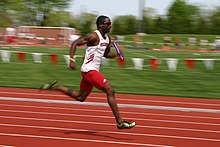Portal:Sport of athletics/Selected article/36
A relay race is a racing competition where members of a team take turns completing parts of racecourse or performing a certain action.

In athletics, the two standard relays are the 4 × 100 metres relay and the 4 × 400 metres relay. 4 × 200, 4 × 800, and 4 × 1500 m relays exist as well, but they are rarer. Mixed-gendered 4 × 400 metres relays were introduced at the 2017 IAAF World Relays, repeated at the 2018 Asian Games, the 2019 World Championships in Athletics and were added to the 2020 Summer Olympics. In addition, a 2 × 2 × 400 m and shuttle hurdles mixed relay races were introduced at the 2019 IAAF World Relays.
Traditionally, the 4 × 400 m relay finals are the last event of a track meet,[citation needed] and is often met with a very enthusiastic crowd, especially if the last leg is a close race.[A] It is hard to measure exact splits in a 4 × 400 (or a 4 × 100) relay. For example, if a team ran a 3-minute 4 × 400, it does not mean every runner on the team has to run a 45-second open 400, because a person starts accelerating before they have the baton, therefore allowing for slightly slower overall open 400 times. A 4 × 400 relay generally starts in lanes for the first leg, including the handoff. The second leg then proceeds to run in lanes for the first 100 metres, after which point the runners are allowed to break into the first lane on the backstretch, as long as they do not interfere with other runners. A race organizer then puts the third-leg runners into a line depending on the order in which they are running (with the first place closest to the inside). The faster teams pass first, while the slower teams have to slide in to the inside lanes as they come available.
According to the IAAF rules, world records in relays can only be set if all team members have the same nationality. Several superior marks were established by teams from a mixture of countries and were thus never ratified.
Notes edit
- ^ Each segment of the relay (the distance run by one person) is referred to as a leg.